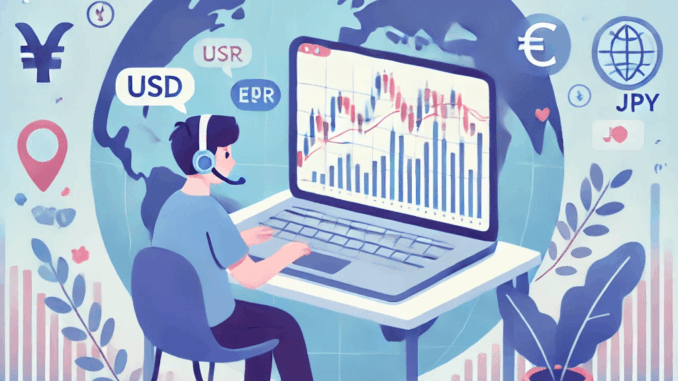
Forex trading, also known as foreign exchange trading or currency trading, is the process of buying and selling currencies in the global financial market. It is one of the largest and most liquid markets in the world, with a daily trading volume exceeding $7 trillion. Forex trading allows individuals, institutions, and businesses to exchange currencies, speculate on price movements, and hedge against risks in international transactions.
How Forex Trading Works
Forex trading involves trading currency pairs. A currency pair represents the value of one currency against another. For example, in the pair EUR/USD, the first currency (EUR) is the base currency, and the second currency (USD) is the quote currency. If the EUR/USD pair is trading at 1.10, it means 1 euro is equal to 1.10 US dollars.
Forex trading happens in the over-the-counter (OTC) market, meaning there is no centralized exchange. Instead, it is conducted electronically via a network of banks, brokers, and financial institutions.
Who Participates in Forex Trading?
The forex market attracts a wide range of participants, including:
1. Retail Traders: Individuals trading for personal profit.
2. Banks: Major players that facilitate currency trading for clients and themselves.
3. Hedge Funds: Institutions that trade currencies for speculative purposes.
4. Multinational Corporations: Companies involved in international trade and investments use forex to manage currency risks.
5. Governments and Central Banks: These entities influence the forex market through monetary policies and currency interventions.
Key Features of Forex Trading
1. High Liquidity: With trillions of dollars traded daily, forex is the most liquid financial market.
2. 24/5 Market: Forex operates 24 hours a day, five days a week, enabling traders across time zones to participate.
3. Leverage: Traders can control larger positions with smaller amounts of capital, thanks to leverage provided by brokers.
4. Volatility: Prices in the forex market can change rapidly, creating opportunities for profit (and risk).
Why Do People Trade Forex?
1. Speculation: Traders aim to profit from changes in currency values.
2. Hedging: Businesses and investors use forex to protect against unfavorable currency movements.
3. Arbitrage: Some traders exploit differences in currency prices across markets for profit.
Basic Concepts in Forex Trading
1. Pip: The smallest price movement a currency can make.
2. Spread: The difference between the bid (buy) and ask (sell) prices.
3. Lot Size: Refers to the volume of a trade, with standard lots equaling 100,000 units of currency.
4. Margin and Leverage: Margin is the deposit required to open a position, and leverage allows traders to control more money than they have deposited.
Risks Involved in Forex Trading
While forex trading offers opportunities, it also comes with significant risks:
• Market Volatility: Rapid price fluctuations can lead to large losses.
• Leverage Risk: High leverage amplifies both profits and losses.
• Lack of Regulation: Some forex brokers operate without proper regulation, posing risks for traders.
Getting Started with Forex Trading
1. Educate Yourself: Learn the basics of forex trading, market analysis, and risk management.
2. Choose a Broker: Select a reputable and regulated forex broker that meets your trading needs.
3. Use a Demo Account: Practice trading without risking real money.
4. Develop a Strategy: Define your trading goals, risk tolerance, and methods of analysis.
5. Start Small: Begin with a small amount of capital and gradually increase as you gain experience.
Forex trading offers immense opportunities for profit, but it also requires knowledge, skill, and discipline. Whether you’re a beginner or an experienced trader, understanding the fundamentals and managing risks is crucial to success. With its high liquidity, accessibility, and potential for returns, forex trading continues to attract millions of participants worldwide.
Leave a Reply